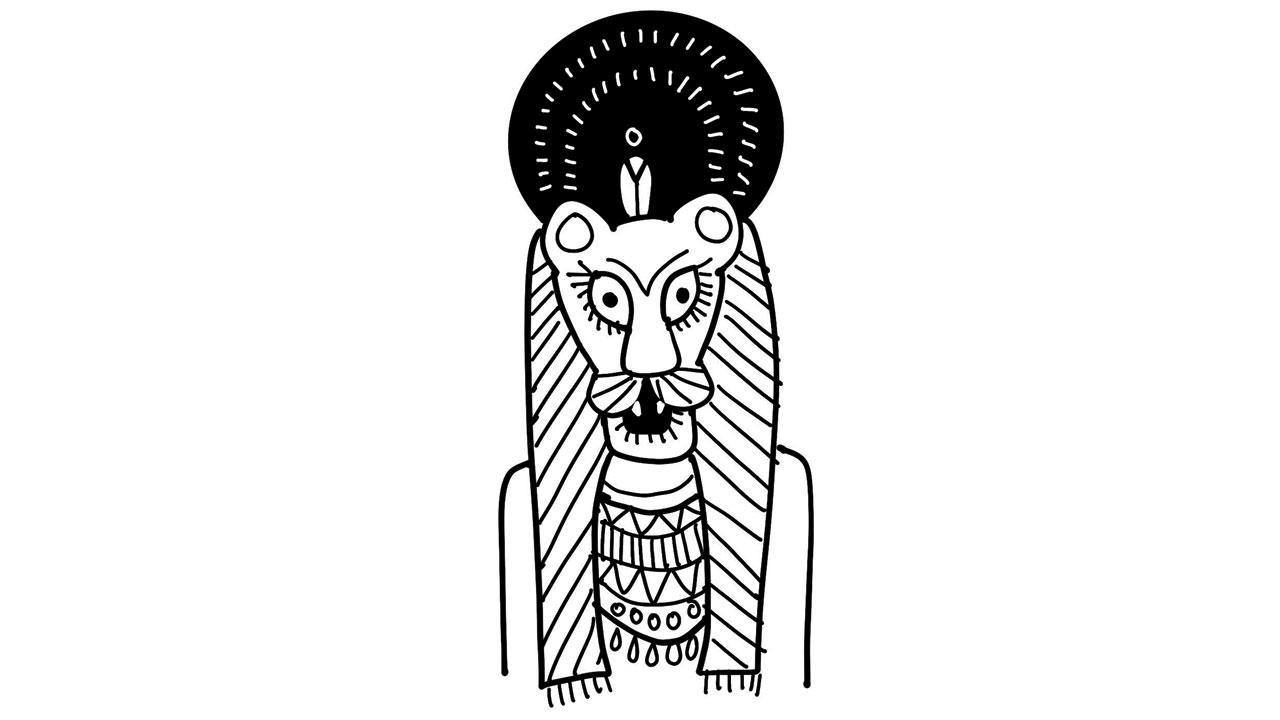They all became part of one family, whose patriarch was Osiris, lord of the afterlife, connected through Horus, to the pharaoh, ruler of this world.

Illustration/Devdutt Pattanaik
 If you visit the Mumbai museum of Chhatrapati Shivaji Maharaj Vastu Sangrahalaya in December, you will see artwork from ancient Egypt—the image of the lion-headed goddess Sekhmet and the river-god Hapi. Both images were carved nearly around 1,000 BCE, ie 3000 years ago, in the final years of the great Egyptian civilization. This was when the Vedic corpus had just reached its final form in the Ganga plains of India. During this period, India did not have any monumental art. All we have from this period is pottery fragments. But while the Egyptian gods are no longer worshipped, and are barely remembered, the Vedic hymns continue to be venerated in India.
If you visit the Mumbai museum of Chhatrapati Shivaji Maharaj Vastu Sangrahalaya in December, you will see artwork from ancient Egypt—the image of the lion-headed goddess Sekhmet and the river-god Hapi. Both images were carved nearly around 1,000 BCE, ie 3000 years ago, in the final years of the great Egyptian civilization. This was when the Vedic corpus had just reached its final form in the Ganga plains of India. During this period, India did not have any monumental art. All we have from this period is pottery fragments. But while the Egyptian gods are no longer worshipped, and are barely remembered, the Vedic hymns continue to be venerated in India.
Nourished by the river Nile, Egyptian culture began with many settlements on its banks and in the delta, each its own god and chieftain. Eventually, after many battles, by 3000 BCE, only one king prevailed. Known as lord of two lands, he united Upper Egypt (the river) and Lower Egypt (the delta). But this one all-powerful king did not wipe out the many gods of the Nile. They all became part of one family, whose patriarch was Osiris, lord of the afterlife, connected through Horus, to the pharaoh, ruler of this world.
This pharaoh, ruler of earth, was protected by the lion-headed goddess Sekhmet, who also nourished him in the form of Hathor, the cow, who carried the sun between her horns. The kingdom’s prosperity was guaranteed by the annual flooding of the Nile which created rich fertile alluvial plains on the river banks. Hapi was the god of this flooding. He was depicted as a blue-coloured god but with breasts, making him both male and female.
The guardian lion, the nourishing cow, the river-god are themes Hindus are very familiar with. In the Puranas, the earth is visualised as the cow, Bhu-devi, who is protected by Vishnu. Vishnu takes the form of the mighty man-lion, Narasimha, rips apart a demon, and protects his devotee. Narasimha’s power is visualised as the female Narasimhi. And the river-goddesses in India are visualised as buxom damsels holding pots in their hands, riding dolphins and turtles, often seen at the doorway of temples. Was there a connection with India?
The Indian images come almost 1,500 years after Egyptian art, around 500 CE. At this time the old Vedic rituals had been completely reimagined to counter the monastic influence of Buddhism and Jainism. In the Vedic world, the gods were celestial and formless and the rituals involved temporary structures like fire altars made of bricks. But in the newly evolving Hinduism, gods and goddesses were embodied and enshrined in temples, dressed and fed, much as in temples of ancient Egypt.
By the time the Hindu gods rose, Egypt had turned Christian and had cancelled its old gods, having condemned them as false and pagan. One formless god prevailed. The true god, as per his followers. This true god’s son was born of a virgin and artists depicted him in her arms. This art was much like the ancient Egyptian art depicting the son of Osiris, the eagle Horus, in the arms of his mother, Isis, who was both the nourishing cow Hathor and the guardian lioness Sekhmet. And this true god’s son would be killed by his enemies, and he would resurrect himself, much as Osiris was resurrected by Isis, and made immortal in the afterlife. Some ideas never die, they repeat themselves, like the timeless flooding of the Nile.
The author writes and lectures on the relevance of mythology in modern times. Reach him at devdutt.pattanaik@mid-day.com
 Subscribe today by clicking the link and stay updated with the latest news!" Click here!
Subscribe today by clicking the link and stay updated with the latest news!" Click here!










